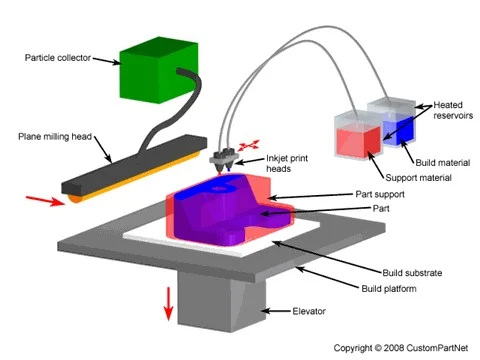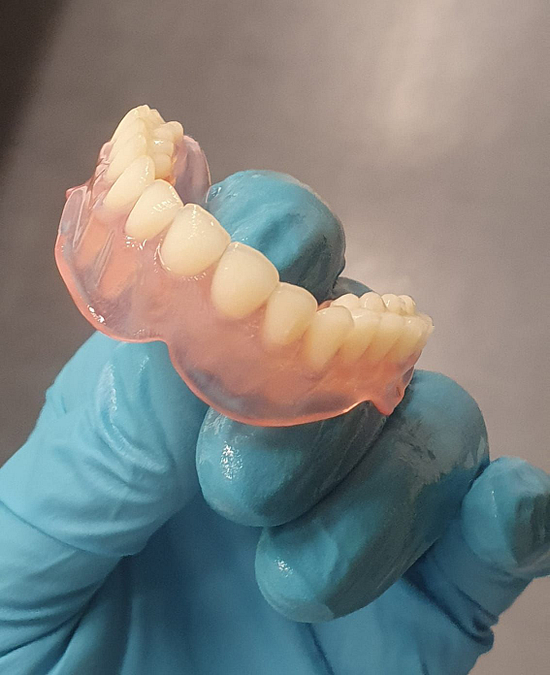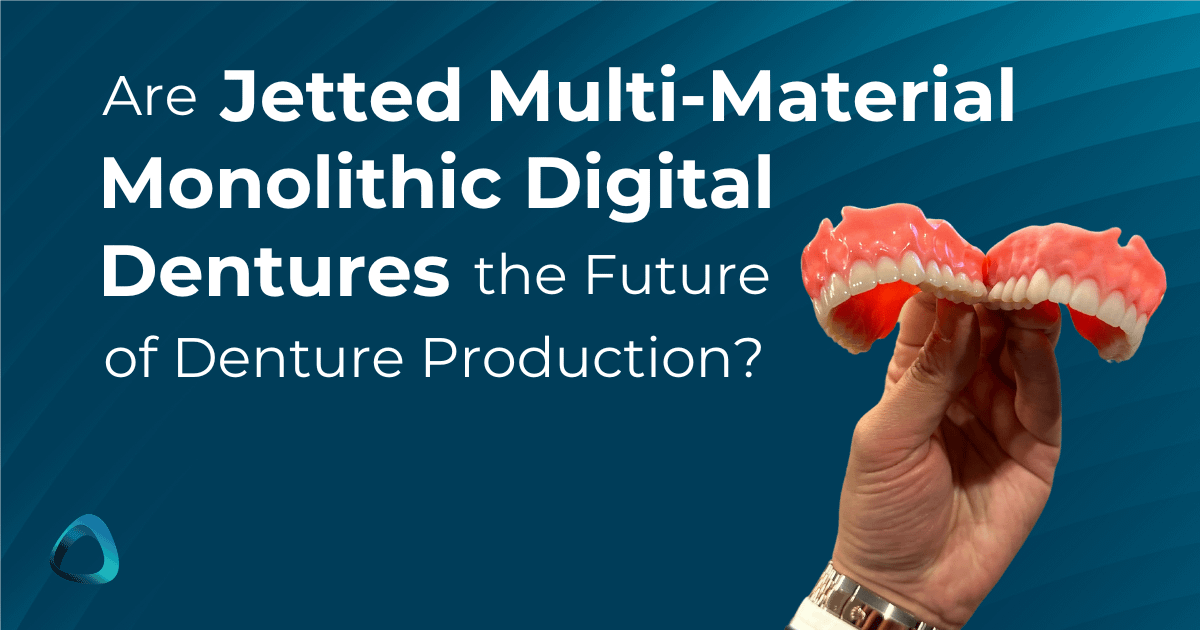On February 21, 2024, 3D Systems unveiled its solution for jetted, monolithic (one-piece) dentures by introducing multi-materials - NextDent Jet Denture Teeth and NextDent Jet Denture Base.
Traditionally, options to fabricate dentures have been limited to heat-cured or self-cured materials and, more recently, CAD/CAM milled and 3D printed dentures.
The downside of milled or printed dentures is that they are often made from a monolithic material. One material for teeth and one for the base (a key exception is Ivotion by Ivoclar). These are then glued together.
Polyjet printers allow the user to print a monolithic denture out of multiple colours. The company Stratasys was the only player in the dental space that provided this solution, and now it sounds like NextDent will be entering too.
So, this is exciting news for the advancements of digital dentures and their production.The Technology Behind One-Piece MultiJet/PolyJet Digital Denture Production
As an advanced method of 3D printing technology, inkjet 3D printing, also known as PolyJet printing or MultiJet printing within the dental scope, use inkjet heads to deposit multiple droplets of different colors or photopolymer materials onto the 3D printer build platform and then cure using a UV light.
The process of a multi-material 3D printing system, where a build platform is lowered to allow inkjet print heads to deposit layers of build and support materials from heated reservoirs, which are then milled for precision, with excess particles collected, to create a 3D part.
Inkjet printing technology is unique compared to the typical resin 3D printing process. This is mainly due to its simultaneous ability to print multiple materials in various base colors, tooth shades, and toughness and strength in a single print.
Will Multi-material Monolithic Jetted Digital Dentures Surpass Traditional Dentures?
Speaking from personal experience, 3D-printed dentures are the latest hot commodity to have in your practice, with more labs going digital - but I sometimes feel we need to understand the longevity of the materials fully.
Although, 3D Systems seems to have tackled a fair few frustrations that most dental technicians (like myself) can relate to - dentures that are as realistic, esthetic, and durable as traditional ones through the use of their Multi-material Monolithic Jetted Denture Solution. The reality is we still dont know how any of these materials hold up long term.
It’ll be interesting to see if this is true in a few years and how well they hold up compared to your typical heat-cured dentures.
It’s safe to say that there is a lot of untapped potential for the future of digital denture production. It’s a growing industry - forecasted to reach $2 billion by 2028 - so we can expect more and more companies to look into moving toward the realm of 3D-printed dentures.
Not many 3D dental printers currently allow for using multiple materials in one print without human interference. Currently, this process is split into two: printing a denture base and denture teeth separately and bonding them.
How Many One-Piece Digital Denture Solutions Are There?
Stratasys’ Industrial Lab 3D printer, the DentaJet J5, is one of the only printers on the market capable of simultaneously printing five materials. The DentaJet J5 has been somewhat successful since its launch in labs, so there seems to be some demand for these UV-cured inkjet printers, which can create realistic multi-color dentures in one step. But it has not been hugely popular and mainstream like simply printing dentures using resin printers. This is like due to cost of these polyjet machines.
So, for now, it’s no surprise that 3D Systems, with its ProJet MJP 3600 Dental, and Stratasys, with its DentaJet J5, are leading the future of full colour digital denture production by making strides in this market.
However, the field does look like it is becoming more competitive, with other printer manufacturers also creating realistic multi-material 3D printing solutions. The Netherlands-based company, Lake3D, currently utilizes additive manufacturing 3D printing technology and specializes in proprietary, voxel-based, multi-material jetting. The company incorporates its printing platform with materials and software for prosthetic and denture printing.

Lake3D's prototype denture, printed in one piece, using their own printer, software and materials.
Lake3D has also started a co-creation project within the smart industry field lab Multi Material 3D to get a multi-material, multi-color 3D printing technology up and running specifically for dental crowns. It’s pretty amazing how far and how quickly dental innovations have accelerated through digital technology.
Alternatively, other 3D printers from technology companies don’t currently have their foot in the dental industry but would be capable of inkjet printing dentures. Quantica, for example, has their NovoJet OPEN - an inkjet-based multi-material benchtop printer that is an open system for application research and development. Their 3D printer can combine up to 7 different materials in a single process. That’s two more than what Stratasys’ DentaJet J5 can currently produce.

Quantica's NovoJet OPEN 3D printer.
So, we could potentially see similar printers like Quantica’s NovoJet OPEN enter the dental market with the right dental resin.
TL;DR
The introduction of 3D Systems’ NextDent Jet multi-material, one-piece denture base and denture teeth resin's is certainly interesting. This part of the market has been dominated by stratasys for a long time because they were simply the only ones really marketing in this space.
Does this mean there will be more interest in this type of technology for dentistry? It’s hard to deny the efficiency of inkjet 3D printing technology and multijet materials for monolithic 3D digital denture printing. Not only do you not need to stand by the printer to change cartridges or resin trays with a new resin, but also you can print multiple different indications on the same build platforom.
The issue is still the cost. These polyjet printers are significantly more expensive than resin printers and is likely why they have not seen a huge explosion in adoption like other parts of 3D printing. Regardless, it’s good to see dental technology like the DentaJet J5 and NextDent Jet printer resins.
What are your thoughts on this technology for denture production?


The 2Hue color system for the production of PRIMERO veneered zirconia crowns- and bridges developed in 2006 shows the same motivation as Nextdent dentures. That is to design and produce aesthetic restorations automatically. In the 2Hue color system the inner-structure of the teeth (dentin/incisal boundary) was developed from teeth colors by artificial intelligence of big data of natural dentin shapes. Great stuff!